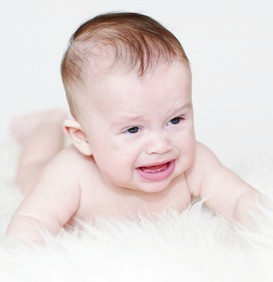11 Reasons For Crying Babies And How To Soothe
Crying babies have reasons to cry. Some are crying all the time, some less
often. But there is always a reason.
 |
 |
Maybe a well-defined one, but could also be hard to explain and eliminate.
With time every parent learns their baby’s cry language. With my son now I can hear it from a different room if it is a cry that I need to rush to or just a “I dropped a toy and can’t reach” type of cry. A skill to identify baby’s cry has a learning curve, and until you master it, you pretty much have to go by the book.
Learning crying babies' patterns is an interesting task. And even though it takes time, mom’s sensitivity to crying babies is at its highest right after giving birth.
Every mom can tell her baby’s cry from a group of kids. Mom’s brain is tuned on to her little one’s cry and is extremely sensitive to and irritated by it. A mother may more easily block other crying babies, but hers is an immediate call to action. This is actually hormone prolactin at work. Prolactin is what turns women into mothers.
Following are 2 most common myths about crying babies. You probably already heard them and formed your opinion, however, here are some facts.
Myth #1: It is good to let a baby cry himself/herself to sleep

This approach has earned itself many supporters, but even
more negative reviews. At the age when a baby is still a baby, why would he/she
cry if not uncomfortable, anxious or in pain? What are we trying to teach crying babies by not responding to their screams?
It may seem like the technique works, since most excessively crying babies are falling asleep eventually. I think they do
because they cry themselves to a state of emotional distress, when their
nervous system shuts itself down to prevent further damage. From that time on
they fall asleep on their own, simply because they were trained like a cat or a
dog. What they also learned is that they can’t trust or rely on their mother.
If we think about baby crying more deeply and analyze it, it becomes clear that no one cries for no reason. Our babies’ reasons simply seem subtle and tiny. A sudden noise or flash of light can startle them and losing the sight of their mommy can make them cry. They are little creatures with big emotions deserving huge respect.
Instead of training them and following rigid advice, it is in our ability to make crying babies feel secure, confident and supported. A confident baby will grow into a confident kid. It doesn’t mean spoiling them with our attention. But quite honestly, what else does a baby need? Attention, love and care are all baby food supplements. They know and understand nothing but this.
Myth #2: Crying is good for baby's lungs
Some also believe that crying is good for baby’s lungs and is a good emotional outlet. Many doctors feel skeptical about it though. First, it is known that baby’s lungs get enough activity and stimulation from their normal functioning and unavoidable occasional crying. And besides, how is it that it is bad for an adult to be in tears, stress and emotional exhaustion, but somehow good for babies?!
Up until the age of 2.5 my son was displaying many interesting reactions to usual evens. Usual to me, but new to him. Sometimes he looked like he didn’t know how to cope with a certain emotional state. Let alone newborns!
We all learn something all our lives, babies do too from the first moments outside of the womb. And since they don’t read books or go to school, we are the only source of every new knowledge for them. That is why our task as parents is to determine the reasons for crying babies, eliminate them, and teach them how to feel about these reasons in future.
So Why Do Babies Cry?

1. Hunger or thirst. It is the most common reason for crying babies. It is also the easiest to satisfy. Breastfeed. Aside from food and drink baby sucking has a great soothing effect. It is best to nurse your baby before he/she has to signal hunger through crying. Look for other signals like mouth opening, bringing hand to the mouth or finger sucking.
Solution: nursing
2. Wet or dirty diaper. Different babies feel differently about wet and dirty diapers. Some are extremely sensitive. In addition, long contact of dirty diaper with the skin can cause irritation and redness. So a baby may continue crying even after being changed. Look at the diaper area skin and apply diaper rash cream if needed.
Solution: changing
3. Hot or cold. Touch your baby to see if his/her hands and nose are cold or too warm and cheeks are red. Also, many babies dislike being undressed, especially when their skin comes in contact with cool air. Change your baby in a warm room.
Solution: dressing warmer or lighter
4. Tired or sleepy. Some babies fall asleep on their own, for others it is a difficult process and they may need some help. Some simply need to cry a little before falling asleep to release tension.
Solution: holding, bouncing, rocking, singing, patting baby’s back, stroking baby’s head , turning on gentle music, swaddling, walking, rocking in a chair, strolling, carrying in a sling, soothing baths (with chamomile or lavender oil added)
5. Fear, anxiety or insecurity. Your baby can be startled and frightened easily. The outside world is overwhelming by itself and gets even worse with a sudden flash of light, unfamiliar sound or the absence of mom and dad. Swaddling is often effective in helping babies feel comfortable and secure.
Solution: nursing, holding, patting baby’s back, stroking baby’s head, swaddling, carrying in a sling, giving a bath (with chamomile or lavender oil added)
6. Gassiness. A baby may cry because of the trapped wind in his/her intestines. You’ll know that, if your baby is pushing up legs and arching when held. The best way to relieve trapped wind is to lay the baby down on a soft surface on the back and to push up the legs to the chin. Repeat several times.
Try adjusting your diet, if the baby is breastfed and is gassy. Visit Food Avoidance section for a list of foods to avoid while breastfeeding.
Remember: If your baby is allergic to dairy, make sure to choose non-dairy probiotics. Our favorite is dairy-free organic Raw Probiotics for Kids (by Garden
of Life).
Solution: burping, holding, massaging, pushing baby’s legs up, applying warm towel compress to the tummy, holding naked skin to skin, giving probiotics and taking probiotics yourself.
7. Colic. If your baby seems like crying all the time during first 3-4 months of life, cries every day at about the same time and for about 2-3 hours, it could be colic. Visit Colic In Infants section to read more.
Solution: nursing, burping, holding, massaging, bouncing, rocking, singing, patting baby’s back, stroking baby’s head, turning on music, swaddling, walking, rocking in a chair, strolling, carrying in a sling, taking for a car ride in a car seat, turning on white noise, soothing baths (with chamomile or lavender oil added), distracting, probiotics
8. Breastfeeding. If your baby cries mostly at feedings (during or after), the cause is breastfeeding itself or your milk supply. Check positioning and latch-on.
Watch your baby nurse and listen how he/she swallows. There should be a swallow after every suck or two. Otherwise, your milk supply may be low or your let down slow; or on the other hand, you may have an oversupply. If your baby starts crying shortly after the feeding, he/she may be suffering from reflux, swallowed gas or food sensitivity to something in your diet.
Solution: burping during and after feeding, each of the links has a list of tips
9. Growth spurt. This is the time when your baby is hungrier than ever before and may cry more as a result. Feed on demand and if the baby calms down after nursing, try feeding him/her sooner next time. Watch for hunger cues like mouth opening and finger sucking.
Solution: nursing
10. Fever. Check your baby’s temperature to rule out fever. If it is elevated, follow your pediatrician’s directions and take into consideration your baby’s medical history and health condition.
Solution: nursing, talking to the doctor
11. Pain. If baby crying is not the result of anything listed above, can your baby be hurt or in pain? This type of cry is more like a shriek and is hard to stop. Call your doctor if you suspect pain, but unable to help your baby. Teething may be quite painful for some too.
Solution: cooled down teething rings, teething biscuits, carrying in a sling, talking to the doctor
If you tried everything, but your baby is still crying, and you feel like you are running out of patience, leave your baby in the crib in a safe position (on the back) and leave the room.
Taking a break will calm you down. And you need this for two reasons. First, your baby is nervous and tense when you are. Second, you may have an inclination to shake the baby out of frustration, and this is a no-no! Shaking a baby may lead to serious brain injury.
There are many ways to show your love and devotion to your kids and to win their trust. Breastfeeding is the most natural one.
Yours,
Viktoriya
Back to top of Crying Babies>other Breastfeeding Problems> Breastfeeding Home










